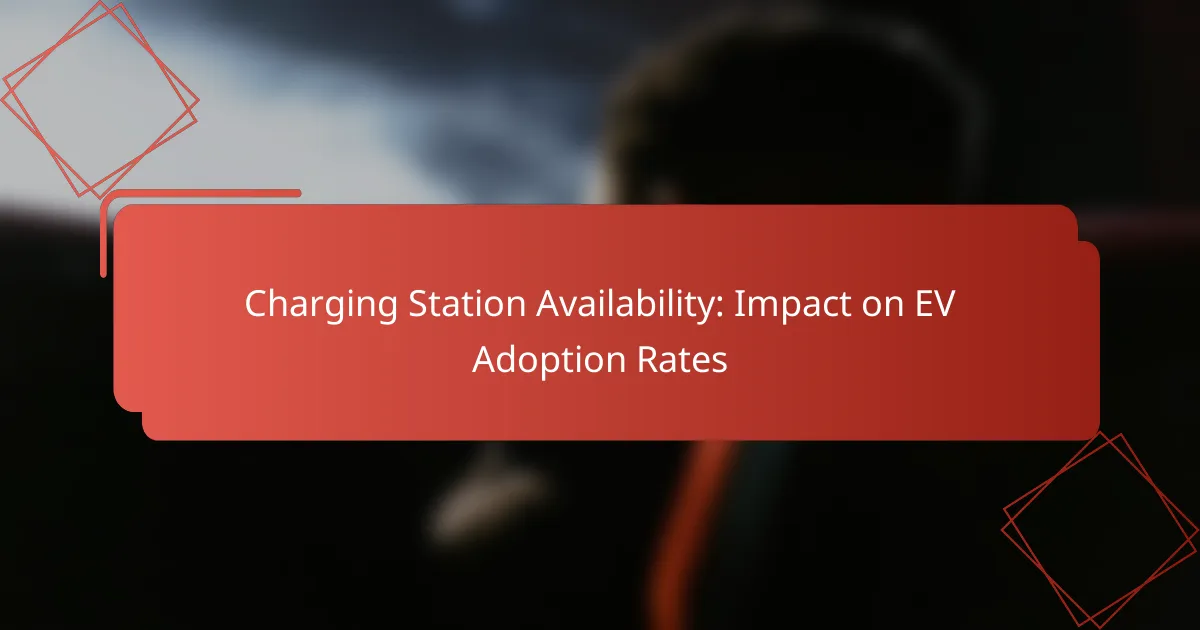Charging station availability plays a crucial role in determining electric vehicle (EV) adoption rates, as a robust network of charging options enhances the practicality of owning an EV. Conversely, limited infrastructure can create apprehension among potential buyers, primarily due to concerns about range and convenience. Factors such as infrastructure investment, government policies, and private partnerships shape the accessibility of charging stations, directly impacting the growth of the EV market.
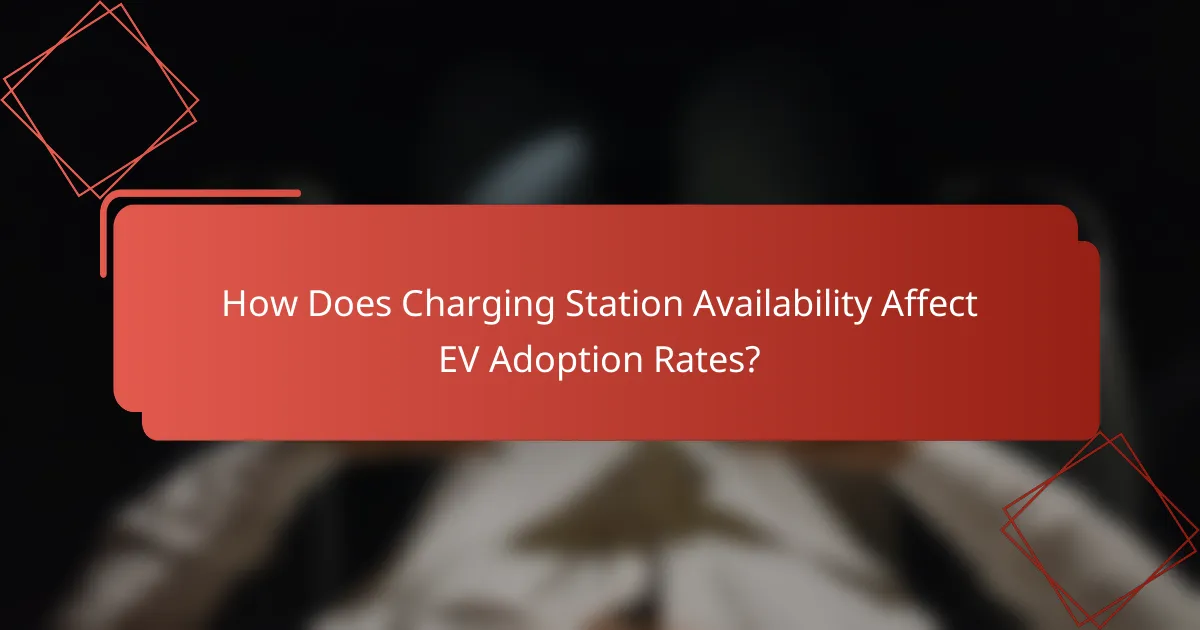
How Does Charging Station Availability Affect EV Adoption Rates?
Charging station availability significantly influences electric vehicle (EV) adoption rates. A higher number of accessible charging stations makes owning an EV more practical, while limited infrastructure can deter potential buyers due to concerns about range and convenience.
Increased accessibility boosts adoption
When charging stations are readily available, potential EV owners feel more confident in their decision to switch from traditional vehicles. Increased accessibility reduces range anxiety, allowing drivers to travel longer distances without worrying about running out of battery.
For example, urban areas with a high density of charging stations often see a higher percentage of EV ownership compared to regions with fewer options. This trend highlights the importance of infrastructure in encouraging consumers to adopt cleaner transportation alternatives.
Limited availability hinders growth
Conversely, limited charging station availability can significantly hinder EV adoption. When potential buyers perceive a lack of charging options, they may opt for gasoline-powered vehicles instead, fearing they will be unable to charge their EVs conveniently.
Regions with sparse charging infrastructure often experience slower growth in EV sales, as consumers prioritize convenience and reliability in their vehicle choices. This creates a cycle where low adoption rates lead to fewer charging stations being installed, further discouraging potential buyers.
Regional disparities impact usage
Regional disparities in charging station availability can create significant differences in EV usage across various areas. For instance, metropolitan regions typically have more charging stations compared to rural areas, leading to higher EV adoption rates in cities.
Moreover, government incentives and policies can vary by region, affecting the development of charging infrastructure. Areas with robust support for EV initiatives tend to see a more rapid increase in both charging stations and EV ownership, while regions lacking such support may struggle to keep pace.
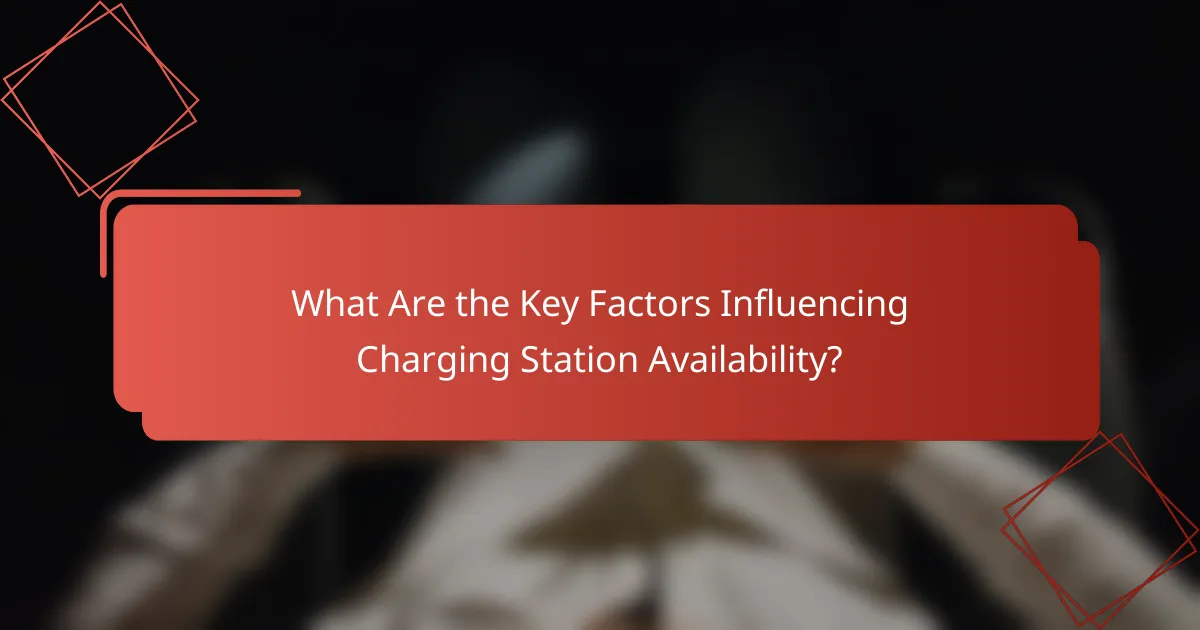
What Are the Key Factors Influencing Charging Station Availability?
Charging station availability is primarily influenced by infrastructure investment levels, government incentives and policies, and partnerships with private companies. These factors collectively determine how accessible and widespread charging stations are, which in turn affects electric vehicle (EV) adoption rates.
Infrastructure investment levels
Infrastructure investment levels play a crucial role in determining the number and quality of charging stations available. High investment can lead to a robust network of fast and convenient charging options, while low investment may result in limited access, particularly in rural areas.
For example, regions that allocate significant funds to develop EV infrastructure often see a higher density of charging stations, making it easier for drivers to charge their vehicles. In contrast, areas with minimal investment may struggle to meet the growing demand for EV charging.
Government incentives and policies
Government incentives and policies significantly impact charging station availability by encouraging both public and private investment. Subsidies, tax credits, and grants can motivate businesses to install charging stations, while regulations can mandate their inclusion in new developments.
In many countries, such as those in the European Union, governments are implementing policies that require a certain number of charging points per electric vehicle. This regulatory approach helps ensure that charging infrastructure keeps pace with EV adoption.
Partnerships with private companies
Partnerships with private companies are essential for expanding charging station networks. Collaborations between governments and private firms can lead to innovative solutions and shared resources, enhancing the overall charging infrastructure.
For instance, utility companies often partner with automakers to install charging stations at strategic locations, such as shopping centers and workplaces. These partnerships can accelerate the deployment of charging stations, making them more accessible to EV users.
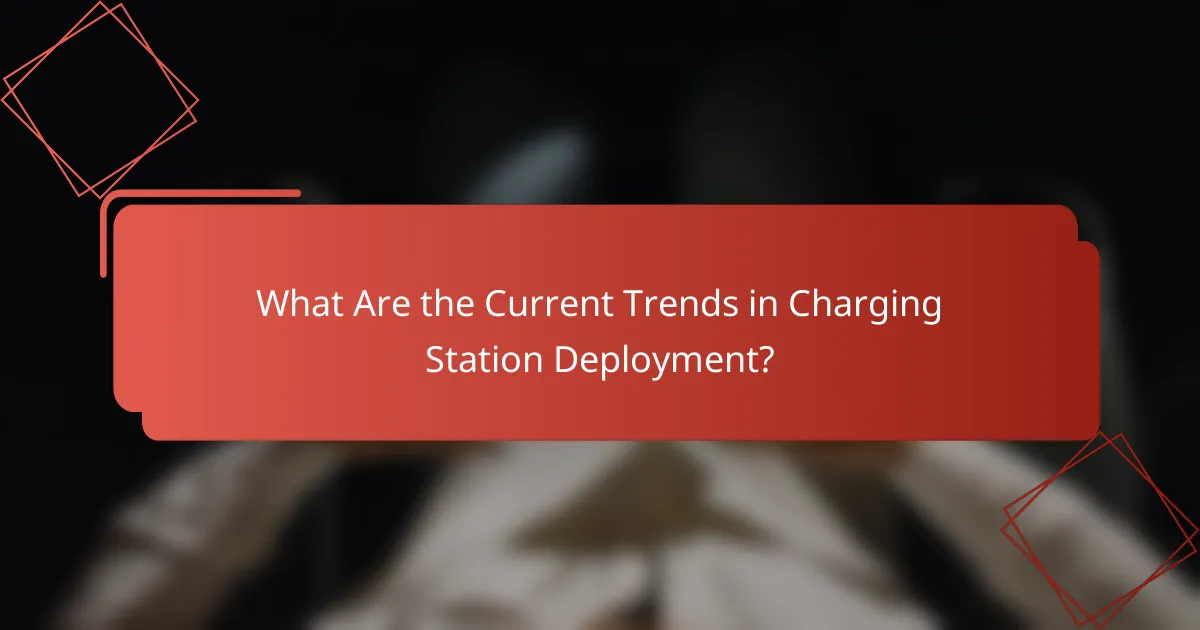
What Are the Current Trends in Charging Station Deployment?
Charging station deployment is rapidly evolving, with a focus on increasing accessibility and efficiency for electric vehicle (EV) users. Key trends include the expansion of fast-charging networks, integration with renewable energy sources, and varying distribution between urban and rural areas.
Expansion of fast-charging networks
Fast-charging networks are crucial for enhancing the convenience of EV ownership. These stations can typically charge a vehicle to 80% in about 30 minutes, significantly reducing downtime compared to standard chargers. Major players in the industry are investing heavily in expanding these networks along highways and in urban centers.
For instance, companies like Tesla and ChargePoint are continuously adding new fast-charging locations, aiming to provide coverage that allows for long-distance travel without range anxiety. This expansion is essential for increasing EV adoption rates, as drivers seek reliable and quick charging options.
Integration with renewable energy sources
Integrating charging stations with renewable energy sources, such as solar and wind, is becoming increasingly popular. This approach not only reduces the carbon footprint of EV charging but also helps stabilize energy costs. Many new charging stations are being designed to utilize solar panels, allowing them to generate their own power.
For example, some charging stations in California are equipped with solar canopies that provide shade while generating electricity. This integration not only supports sustainability but also appeals to environmentally conscious consumers, further driving EV adoption.
Urban vs. rural charging station distribution
The distribution of charging stations differs significantly between urban and rural areas. Urban centers tend to have a higher density of charging stations, making it easier for residents to access charging facilities. In contrast, rural areas often face challenges with fewer charging options, which can deter potential EV buyers.
To address this disparity, various initiatives are being launched to increase charging infrastructure in rural regions. Governments and private companies are collaborating to install more charging stations in these underserved areas, ensuring that all drivers have access to necessary charging facilities, regardless of their location.
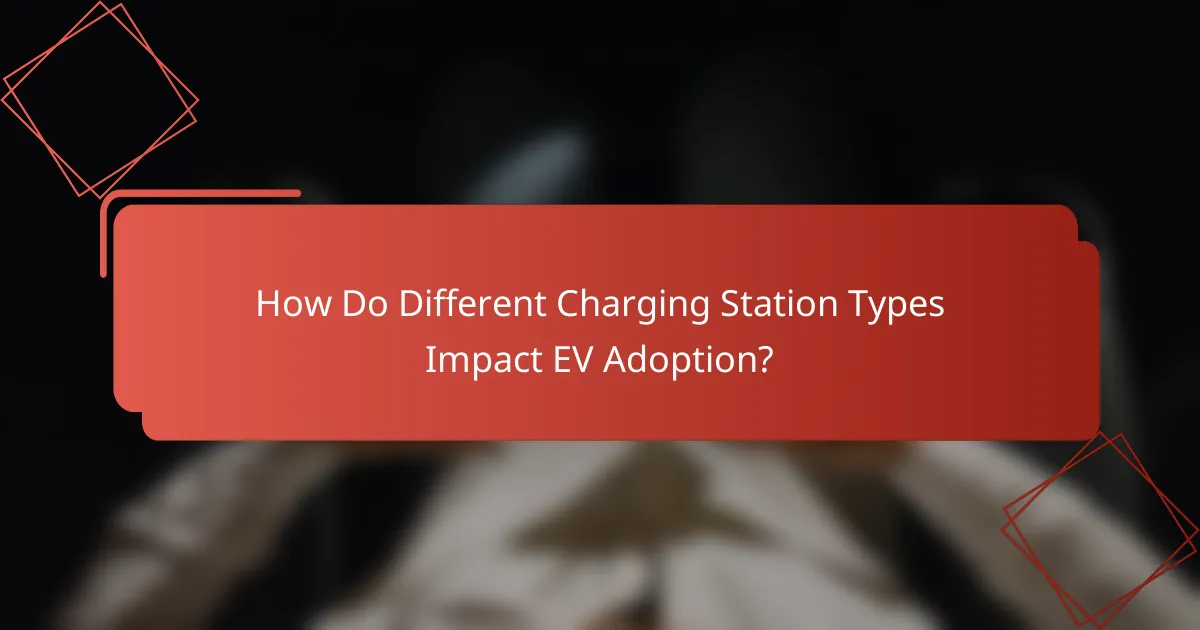
How Do Different Charging Station Types Impact EV Adoption?
The availability and type of charging stations significantly influence electric vehicle (EV) adoption rates. Different charging options cater to various user needs, affecting convenience, accessibility, and overall consumer confidence in EV technology.
Level 2 vs. DC fast chargers
Level 2 chargers are commonly found in residential and public locations, providing a charging speed of about 10 to 20 miles of range per hour. In contrast, DC fast chargers can deliver 60 to 100 miles of range in just 20 to 30 minutes, making them ideal for long-distance travel and reducing downtime.
The choice between these two types often depends on the user’s driving habits. For daily commuters, Level 2 chargers may suffice, while those who frequently travel longer distances may prefer the speed of DC fast chargers.
Home charging vs. public charging
Home charging allows EV owners to conveniently charge their vehicles overnight, typically using Level 2 chargers. This setup is often the most cost-effective and reliable option, as it eliminates the need for frequent public charging stops.
Public charging stations, however, play a crucial role in supporting EV adoption, especially for those without home charging access. The presence of a robust public charging network can alleviate range anxiety and encourage more people to consider EVs.
Workplace charging benefits
Workplace charging stations provide significant advantages for both employees and employers. They offer a convenient charging solution during work hours, which can enhance employee satisfaction and retention while promoting sustainable practices.
Employers can also benefit from potential tax incentives and increased productivity, as employees can charge their vehicles while working. Implementing workplace charging can be a strategic move to attract environmentally conscious talent and support the transition to electric mobility.
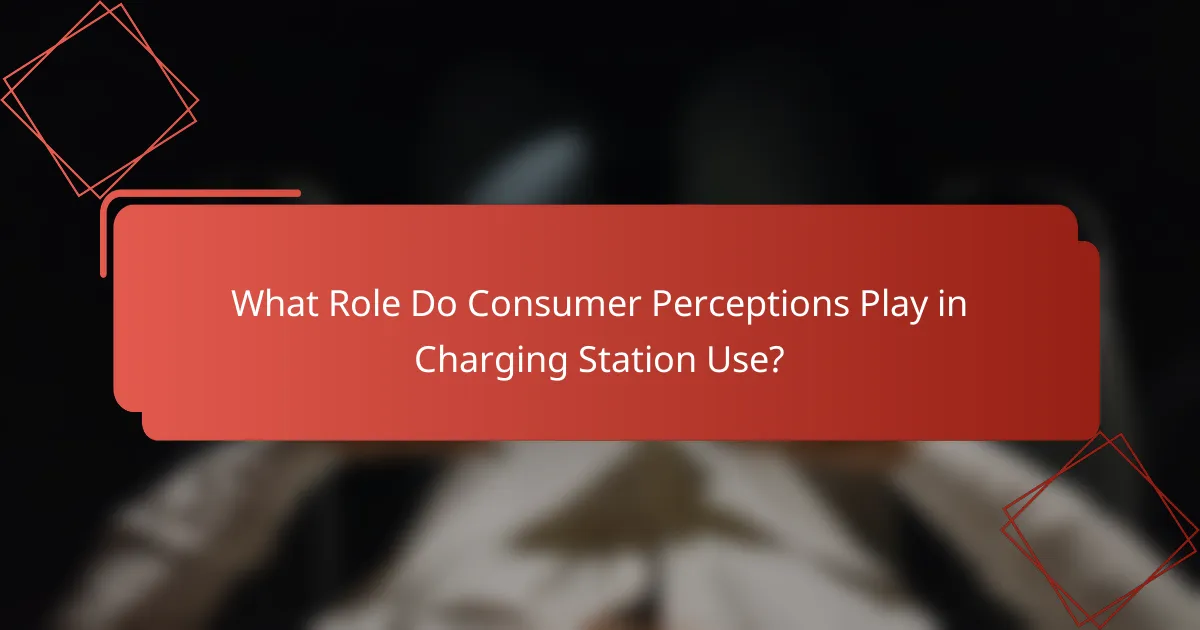
What Role Do Consumer Perceptions Play in Charging Station Use?
Consumer perceptions significantly influence the use of charging stations, affecting electric vehicle (EV) adoption rates. Factors such as trust in charging reliability, awareness of available options, and perceived convenience can either encourage or deter potential EV owners.
Consumer trust in charging reliability
Trust in the reliability of charging stations is crucial for consumers considering EVs. If potential users believe that charging stations are often out of service or frequently occupied, they may hesitate to switch from traditional vehicles. Building a network of dependable charging stations with consistent uptime can enhance consumer confidence.
For example, regions with high charging station reliability often see higher EV adoption rates. Consumers are more likely to invest in an electric vehicle when they know they can easily access functioning chargers without long wait times.
Awareness of charging options
Awareness of charging options plays a vital role in consumer decisions regarding EVs. Many potential EV owners may not know about the variety of charging solutions available, including home charging, public charging, and fast-charging stations. Increased visibility of these options can lead to higher adoption rates.
Effective marketing and information campaigns can help educate consumers about charging infrastructure. For instance, mobile apps that show nearby charging stations and their availability can significantly improve awareness and usage.
Perceived convenience of charging
The perceived convenience of charging stations directly impacts consumer behavior. If charging is seen as a hassle or time-consuming, potential EV buyers may opt for gasoline vehicles instead. Simplifying the charging process, such as offering fast chargers and easy payment methods, can enhance the appeal of EVs.
For instance, locations that provide charging stations at popular destinations or workplaces can make charging more convenient, encouraging more drivers to consider electric vehicles. Additionally, integrating charging into daily routines can help alleviate concerns about charging time and accessibility.
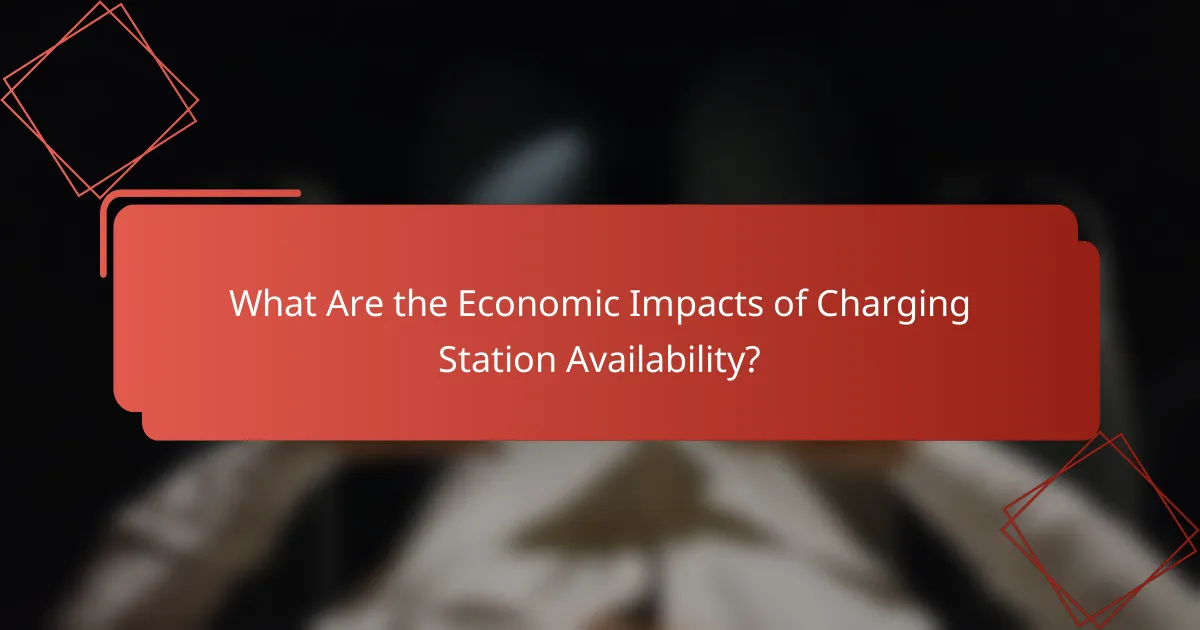
What Are the Economic Impacts of Charging Station Availability?
The availability of charging stations significantly influences the economic landscape surrounding electric vehicle (EV) adoption. Increased access to charging infrastructure can boost local economies, create jobs, and enhance consumer confidence in EV technology.
Influence on local businesses
Charging stations can attract more customers to local businesses, particularly in areas with high foot traffic. Retailers, restaurants, and service providers near charging locations often see increased patronage from EV owners who may spend time shopping or dining while their vehicles charge.
Moreover, municipalities can benefit from increased sales tax revenue as more consumers frequent these areas. Local governments may also incentivize the installation of charging stations to further stimulate economic growth and support sustainable practices.
Job creation in the EV sector
The expansion of charging station networks contributes to job creation within the electric vehicle sector. Roles can range from installation and maintenance of charging infrastructure to sales and customer support in EV-related businesses.
As the demand for electric vehicles grows, so does the need for skilled workers in this field. Training programs and partnerships with educational institutions can help prepare the workforce for these emerging opportunities, ultimately supporting local economies and fostering innovation in sustainable transportation.
